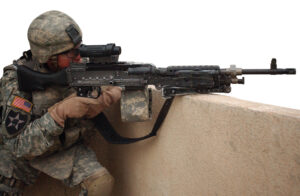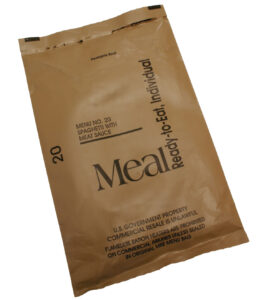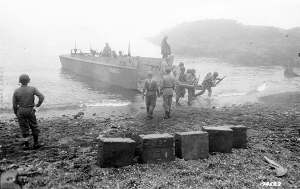Written By: Matthew J. Seelinger
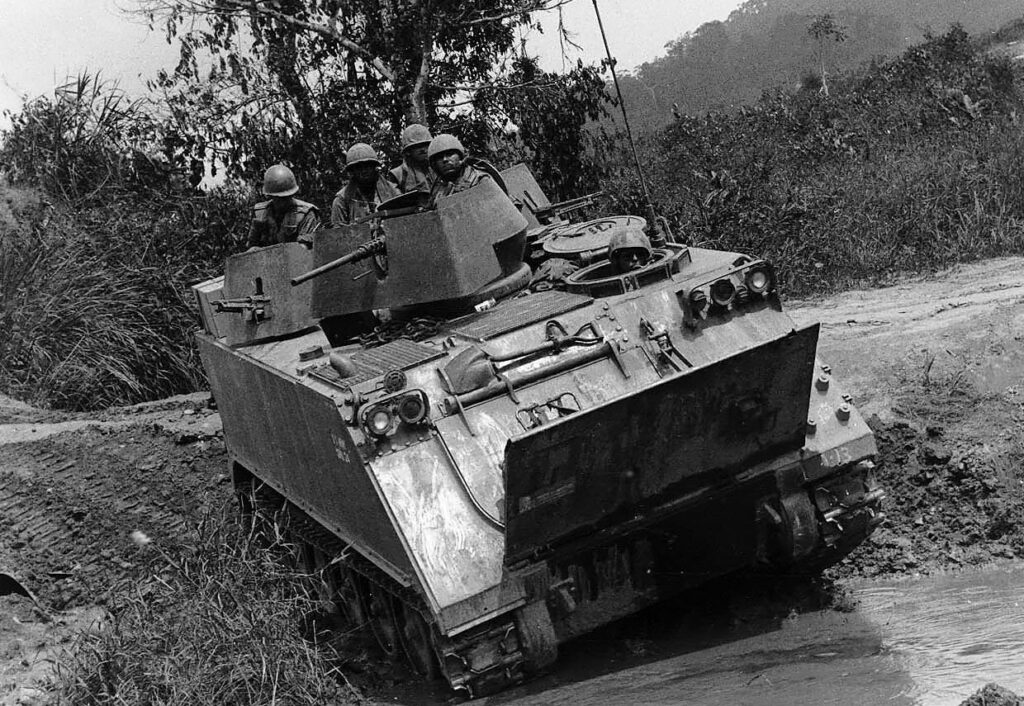
Since the advent of mechanization, the United States Army has continuously sought ways to effectively transport soldiers around the battlefield. While the early trucks used in World War I could bring men close the front lines, their limited off-road mobility and vulnerability to small arms and artillery fire severely limited their use in areas of heavy combat. During World War II, the Army developed the M2 and M3 half-track vehicles to transport men and materiel. Both vehicles were employed primarily by armored infantry regiments and battalions to transport infantrymen supporting armored formations. On each vehicle the rear wheels were replaced by tracks similar to those used by tanks, improving the vehicle’s ability to operate on muddy or snow covered roads.
Most M2s and M3s were also equipped with a .30 or .50 caliber machine gun to provide suppressive fire for advancing infantry or defensive fire against enemy aircraft. Yet the World War II-era halftracks were a halfway measure—the vehicle was thinly armored (6mm to 12mm); mobility, while better than a conventional truck, was still limited, especially in off-road situations; and there was no overhead protection from artillery shell splinters for the driver or the infantrymen riding in the rear compartment.
The Army did produce two all-tracked armored personnel carriers (APC) on a limited basis during World War II. The M39 was an open-topped vehicle based on the M18 Hellcat tank destroyer. Like the M18, it was fast and had great cross-country mobility but lacked overhead protection.
The M44, based on the M24 Chaffee light tank, was a large, fully enclosed vehicle, capable of carrying twenty-five soldiers, but the war ended before it reached full production. In addition, the M44’s large size, nearly that of a city bus, simply made it impractical on the battlefield. Towards the end of the Korean War, the Army introduced the M75, an 18.8-ton personnel carrier originally designed and produced by International Harvester.
Later, the Army brought the Food Machinery and Chemical Corporation (FMC) into the production program. Made of steel and fully enclosed, the M75 could carry ten soldiers and a crew of two. The M75, however, was expensive to produce ($100,000 per vehicle in the early 1950s) and production ceased after only 1,729 vehicles had been manufactured. In 1953, FMC introduced the M59, a less expensive vehicle that utilized a number of off-the-shelf components to keep costs down. Unlike the M75, the M59 was made of lighter aluminum armor and had a limited amphibious capability. One drawback was that M59 was underpowered. Although some 6,300 M59s were produced, none ever saw combat.
In the mid 1950s, the Army issued specifications for a new APC. The specs called for a fully tracked, fully enclosed vehicle that could match the mobility of modern tanks so that tanks and newly developed mechanized infantry units could work together as part of an integrated team. The new APC was to be amphibious and capable of being air dropped. It was also to be easy to maintain and allow infantry easy access and egress. FMC developed two prototype APCs, known as the T113 and T117. The T113 was constructed from aluminum and was thus considerably lighter than the steel T117, allowing it to be used in airborne operations.
The Army was pleased with the overall performance of the T113 and awarded FMC the production contract. After a number of modifications, the Army began accepting the new APC, now designated the M113, in 1960. The Army now had its “battle taxi,” a vehicle capable of bringing infantrymen onto the battlefield, where they would dismount and work in conjunction with tanks. The M113, measuring 15 feet, 11 inches long, 8 feet, 10 inches wide, and 8 feet, 2 inches in height, and weighing just over twelve tons, could carry eleven fully equipped soldiers and a crew of two (driver and track commander).
Its 209-horsepower Chrysler 75M gasoline engine gave the M113 a road speed in excess of forty miles-per-hour. The M113 had a cruising range of approximately 200 miles. The vehicle’s armor, 12mm to 38mm thick, effectively shielded the occupants and crew from small arms fire and shell fragments. Armament consisted of a Browning M2 .50 caliber machine gun operated by the track commander from a hatch in the top of the vehicle. The large ramp in the back allowed soldiers to easily enter and exit the M113, while additional hatches in the top allowed cargo to be loaded and provided additional access points for troops.
The M113 was also amphibious, with its tracks propelling it through the water. The only aspect of the M113 that gave the Army pause was its engine. While reliable and powerful, if hit, the M113’s gasoline engine (and fuel cells) posed a significant fire hazard to the vehicle’s occupants. While the original M113 was in production, the Army and FMC began developing a prototype with a safer diesel engine. Known as the M113A1, the new variant was equipped with a General Motors 215-horsepower diesel engine and first entered Army service in 1964. In addition to being less of a fire hazard, the new engine improved the M113’s range by 100 miles. As a result, the Army phased out the potentially hazardous early model M113s.
The new APC immediately proved successful and was soon equipping the Army’s mechanized infantry units in the United States and Western Europe, along with selected airborne elements. Other nations became interested in acquiring the M113 for their armies, and within a few years, Canada, Italy, Denmark, Spain, Greece, Turkey, and other countries had equipped their armed forces with M113s. The M113 first saw combat in Vietnam shortly after its introduction with the U.S. Army. The first vehicles arrived in Vietnam in 1962 and served with the Army of the Republic of Vietnam (ARVN).
At first, the APCs proved effective against Viet Cong (VC) guerrillas, who had few heavy weapons to counter the M113s. Soon, however, a number of weaknesses in the M113 emerged. In particular, the position of the machine gun left the gunner exposed. During the Battle of Ap Bac on 2 January 1963, ARVN forces lost several M113 gunners to VC guerrillas, who concentrated their fire against the vulnerable M113 crewmen. As a result, ARVN soldiers and their American advisors came up with a number of unauthorized field modifications, adding more machine guns and recoilless rifles to the M113’s standard armament, and developing shields to protect the gunners.
Another modification was the addition of additional floor armor to protect the vehicle from land mines, a favorite weapon of the VC. In addition to extra weapons and armor, ARVN forces used their M113 in ways not envisioned by the U.S. Army. Instead of employing their vehicles as “battle taxis” and using them to transport troops to the battle, the South Vietnamese, with the additional armament and shielded gun positions, used their M113s as light amphibious tanks, charging at enemy positions with guns blazing. These reconfigured models became known as Armored Cavalry Assault Vehicles, or ACAVs.
When the United States began deploying large numbers of combat troops to Vietnam in 1965, thousands of M113s, mostly M113A1 models, accompanied U.S. forces to Southeast Asia. Like their ARVN allies, American soldiers modified many of their M113s to transform them into ACAVs, usually by adding two M60 7.62mm machine guns to the standard .50 caliber armament along with shields for each gun. Other M113s were modified to carry flamethrowers or mortars. Another variant, the M163, featured a General Electric M61 Vulcan 20mm Gatling gun mounted on a modified M113A1.
Originally designed as an air defense weapon, the M163 proved extremely effective against ground targets, especially massed enemy infantry. Other branches of the U.S. armed forces used the M113 as well. Small numbers of M113s were used by U.S. Air Force Security Police to protect Air Force bases in Vietnam The M113 ACAVs and other variants proved successful in the jungles and rice paddies of Vietnam. In addition to being used directly in operations against enemy forces, the Army used M113 ACAVs on convoy escort missions, where their firepower could quickly disrupt an enemy ambush.
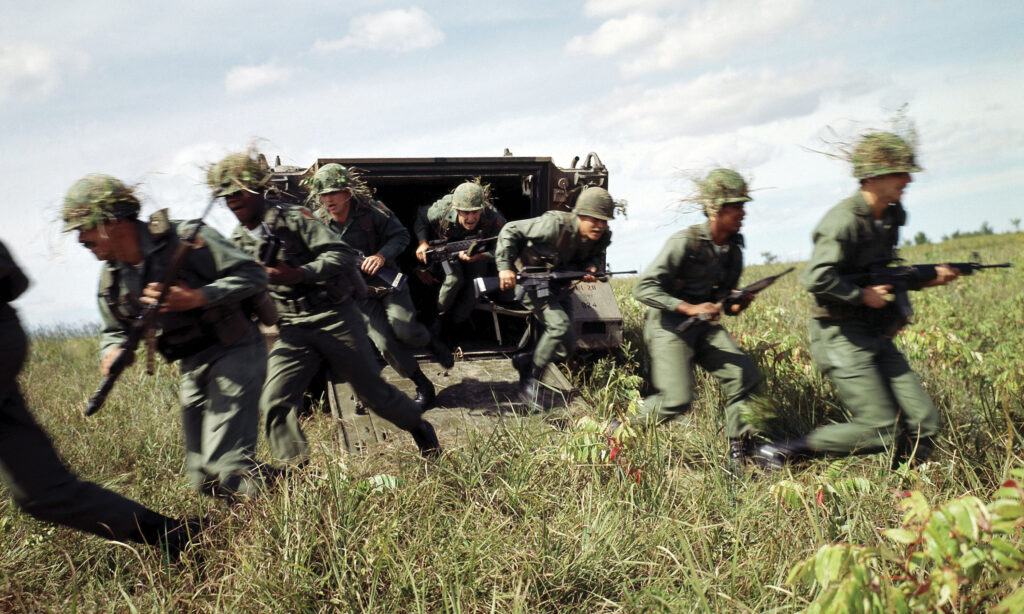
M113 crews quickly learned to adapt to new enemy threats. Due to the danger posed by land mines, most soldiers rode on top of their M113s—even drivers often jury-rigged extensions to allow them to drive their vehicle from on top. Soldiers also augmented the extra floor armor of their ACAVs with sand bags. Another threat to the M113 was the rocket propelled grenade (RPG), usually in the form of the Soviet-designed RPG-7. M113 crews adapted to the RPG threat by using “stand-off” armor (often something as simple as chain link fencing), which would detonate the RPG’s shaped warhead before it made contact with the M113’s hull.
After the Vietnam War, the M113 returned to its primary role as an APC. At the same time, the Army continued to make improvements to the M113, as well as develop new variants to the M113 Family of Vehicles (FOV). In addition to the basic M113 APC, other variants included the M58 Smoke Generator Carrier, M548 Cargo Carrier, M577 Command Post Carrier, M901 Improved TOW Vehicle, and other versions for medical evacuation and engineer missions. A number of other versions were developed for use with specific weapon systems, such as the HAWK air defense missile (M727), Lance ballistic missile (M688), and 81mm, 4.2-inch, and 120mm mortars.
In 1979, the Army introduced the M113A2, which featured an improved suspension and upgrades to the engine’s cooling system. By this time, however, the development of the vehicle intended to replace the M113, the M2/3 Bradley Infantry/Cavalry Fighting Vehicle was in full swing. The Bradley would incorporate many of the lessons learned from the use of the M113 ACAVs in Vietnam into a totally new vehicle with heavier armor and armament than the M113. While the Bradley would eventually replace the M113 in most mechanized infantry units beginning in the mid-1980s, the M113 would see plenty of service in the years ahead.

In 1987, the Army introduced another version, the M113A3, with improved steering controls and a more powerful engine. During Operation Just Cause, the invasion of Panama, in December 1989, the 4th Battalion, 6th Infantry (Mechanized), from the 5th Infantry Division (Mechanized), employed M113s against Panamanian forces loyal to Manuel Noriega. Just over a year later, thousands of M113s and M113 variants saw action with American and coalition forces in Kuwait and Iraq in Operation Desert Storm. Throughout the 1990s, M113s served with American forces during peacekeeping missions in Bosnia and Kosovo.
Most recently, M113 FOV systems have been used in the Global War on Terrorism, especially in support of Operation Iraqi Freedom. Many M113s in Iraq have been upgraded with extra or reactive armor for added protection against RPGs and other threats. Some vehicles have been outfitted with gun shields similar to the ones used on M113 ACAVs in Vietnam. United Defense’s M113A3 Reliability Improvements for Selected Equipment (RISE) program incorporates a host of additional upgrades to the M113A3, including a turbocharged engine, improved transmission and steering, and spall liners to protect the occupants if the vehicle is hit.
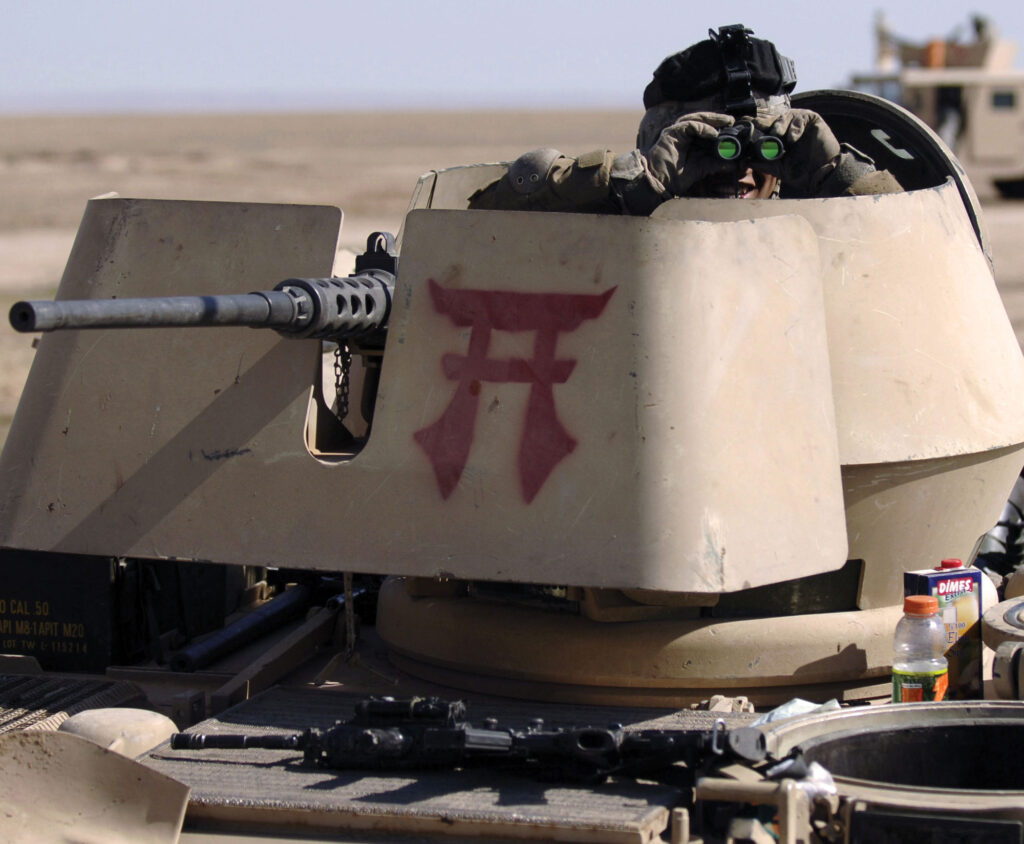
A number of M113s are also used by the Opposing Force (OPFOR) at the National Training Center, Fort Irwin, California. OPFOR M113s are visually modified vehicles (VISMOD) that resemble Russian armored vehicles, such as the BMP-1. Some 80,000 M113 FOV systems have been manufactured to date, and the M113 currently remains in production. The armed forces of over forty nations, and several police departments in the United States, operate the M113 or its variants, making it one of the most widely used armored vehicles in history. Few vehicles in Army history can equal the legacy of the M113, and even after forty-seven years of service, the Army has no plans to retire the M113.


